[Editor’s Note] Since I am not a professional in the display industry, I will briefly analyze these two types of screens. If there are any inaccuracies, I hope you can point them out through comments.
First, let’s talk about the working principles of AMOLED and TFT-LCD. Please see the diagram below.
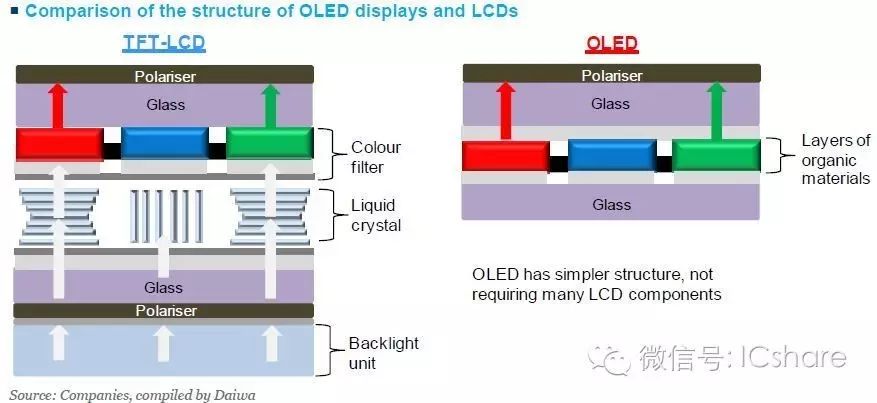
From the diagram, it can be seen that TFT-LCD emits light through a backlight unit, which is controlled by liquid crystals to turn on and off, and then passes through different RGB color filters to display different colors. In contrast, AMOLED is self-emissive, displaying different colors through a combination of different RGB light-emitting components.
Due to the different light-emitting methods, TFT-LCD requires a backlight, making it inherently thicker than AMOLED.
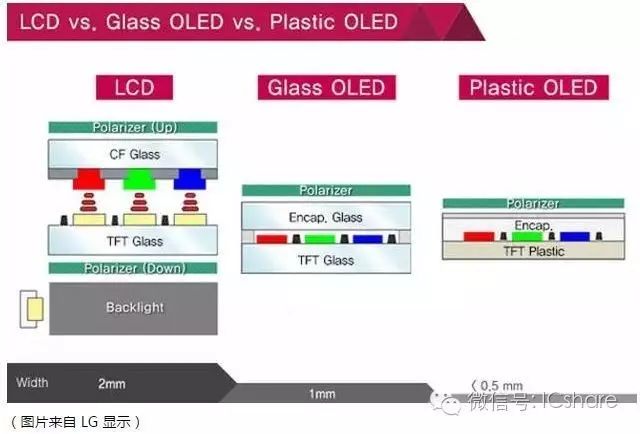 This is an older image. Although in recent years, TFT-LCD has adopted various technologies like In-cell to reduce the overall thickness with touch functionality, AMOLED is still generally thinner than TFT-LCD.
This is an older image. Although in recent years, TFT-LCD has adopted various technologies like In-cell to reduce the overall thickness with touch functionality, AMOLED is still generally thinner than TFT-LCD.
However, because AMOLED is self-emissive, it cannot inject liquid crystals into glass like TFT-LCD; instead, it uses deposition or printing methods to inject the light-emitting materials into AMOLED.
The printing method is still under development. Currently, companies including Samsung use the deposition method for production.
To improve the deposition yield of AMOLED, Samsung has adopted various PenTile technologies for production.
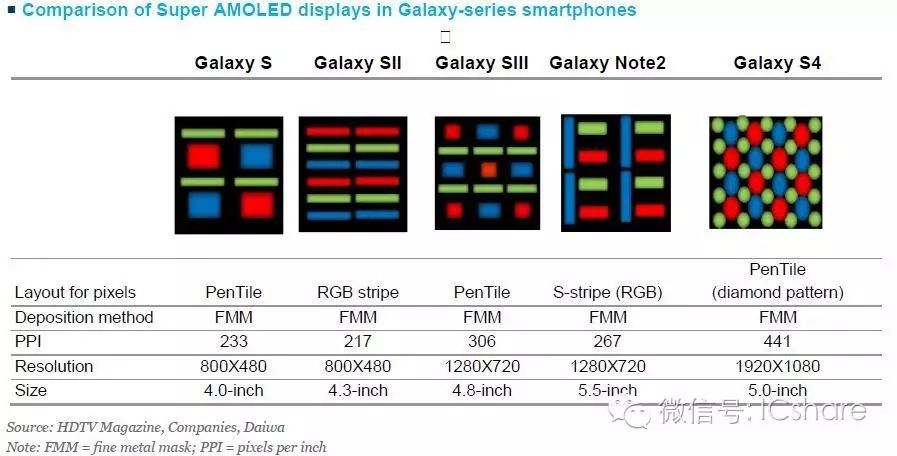
Why does PenTile improve yield? For example, with an FHD resolution of 1920×1080, using PenTile allows for a resolution of only 1920×720, enabling users to see the 1920×1080 effect.
However, this does sacrifice some pixels, which may cause display distortion under certain patterns; however, for natural images or artificially taken photos, this type of distortion is generally not noticeable.
Many people promote AMOLED as being more power-efficient than TFT-LCD, but a test conducted by Zhongguancun Online concluded that testing both AMOLED and IPS materials showed that while the calculation methods for specific projects differ, it is clear that AMOLED is most power-efficient when displaying black, followed by green, and white consumes the most power. On the other hand, devices using IPS screens showed no significant impact on battery consumption when displaying all three colors for extended periods. Therefore, it is evident that using a dark background or desktop can indeed save some power for AMOLED screens, and the effect is quite noticeable. However, for IPS screens, due to the structure and method of display (using backlighting), using dark backgrounds does not necessarily save power. For more details, see http://mobile.zol.com.cn/529/5295530.html
Regarding dimming the brightness, the yellowing of AMOLED colors is also an issue. However, over the years, advancements in AMOLED technology have improved this problem somewhat.
As for the market for AMOLED, due to its thinner profile, many smartphone manufacturers are eager to adopt AMOLED despite its higher cost. However, in the past two years, Samsung reduced supply to domestic brands due to the high sales of its Galaxy series, causing domestic manufacturers to hesitate. But in recent years, as Samsung’s smartphone growth has slowed and its AMOLED production capacity has increased, the price of AMOLED has decreased since last year, leading to a growing number of brands adopting AMOLED.
In addition to Samsung, LG, and Sony, domestic manufacturers are also gradually starting to produce AMOLED, such as Shanghai Hehui, Kunshan Guoxian, BOE, and Tianma, which has also contributed to the gradual decline in AMOLED prices.
Of course, the future of AMOLED is bright, which is the main reason why suppliers are beginning to produce AMOLED. There are three directions to focus on for AMOLED in the future:
-
Flexible Display: This is a significant advantage of AMOLED over TFT-LCD. Since it is self-emissive, unlike TFT-LCD which has a layer of backlight, TFT-LCD cannot be made flexible.
-
Printing Production: The printing method can make AMOLED thinner and easier to create curved screens. However, the printing technology is not yet mature, with only TCL in China researching this technology.
-
VR: With the rise of virtual reality, the number of domestic manufacturers producing VR has increased. However, I often hear users report that when using VR headsets from major foreign companies like Oculus, Sony, and Valve, the experience is excellent, but when using domestic VR headsets, they feel extreme dizziness when moving. Why is this? Generally speaking, a VR headset is just a display worn on the head. What causes motion sickness?
Below, I will demonstrate with a few diagrams.
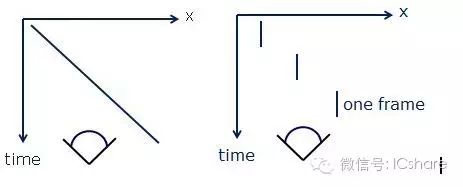
We can see that the left image shows what happens in the real world when an object moves from left to right: over time, the object’s trajectory appears as a line; while the right image shows how any display shows the situation: the object’s image jumps to the next point after displaying for a segment of time; it is not continuous motion.
However, once the person’s head moves, the eyes also have relative motion concerning the displayed object, causing the object’s trajectory to change:
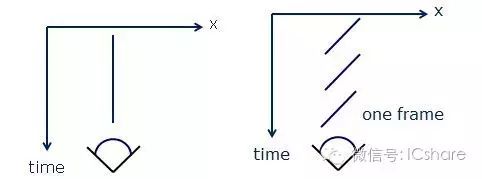
In the right image, when the head turns left, the originally stationary object’s trajectory becomes the one shown in the right image, no longer a point but jumping back to where it “should” be at the end of each frame. However, the visual persistence phenomenon of the human eye retains the images of the previous and current frames, causing the image to leave a trail, leading to dizziness.
To avoid dizziness, there are two methods:
-
Assuming we still have a refresh rate of 60Hz and a head rotation speed of 120 degrees/second, then the head turns 2 degrees within one frame. At the resolution of DK2, the delay within one frame is 19 pixels, and at this time, the image displayed by the headset will be quite blurry. The higher the resolution, the more serious this problem becomes. Calculating with the theoretical limit of human eye resolution, the delay within one frame can reach 600 pixels.
From 60 to 90, to 120, to 200… possibly finally to 1000Hz, at that point, our visual system will completely fail to distinguish between real and virtual. However, it is clear that we cannot currently increase the refresh rate to 1000Hz; currently, Oculus Rift CV1 and HTC Vive adopt a refresh rate of 90Hz, while Sony Project Morpheus adopts a refresh rate of 120Hz.
-
Reducing Persistence: Persistence is a concept from the CRT display era. CRT displays use an electron beam to excite phosphors on the screen to emit light, meaning that in reality, each frame of a CRT display only has a short period when pixels are lit, while the rest of the time they are dark, as illustrated below:

As can be seen, in LCD displays, pixels are always lit within each frame, hence LCD displays are called “full persistence” displays.

The middle image shows that pixels are lit only half the time; while the right image shows that ideally, the screen is lit for only a very short time, which is called “zero persistence.” Due to the visual persistence effect of the human eye, if the refresh rate is high enough, one will not notice that the screen is only lit for a short time during each frame. However, to compensate for the lack of brightness, the intensity of pixels lit within each frame must be greatly increased.
Low persistence displays are significant for VR headsets because they make the object’s trajectory during head movement much closer to the real-world trajectory:

At this time, the motion blur caused by head movement will be significantly reduced. Assuming the same head rotation speed of 120 degrees/second, with a headset refresh rate of 60Hz, and the screen emitting light for 2ms per frame, at DK2 resolution and field of view, the visual delay observed by the eye during the 2ms of light emission would only be 2 pixels, thus eliminating the feeling of dizziness.
However, we all know the basic display principle of LCD: it selectively transmits light by flipping liquid crystals. This means that LCDs find it challenging to use low persistence displays.
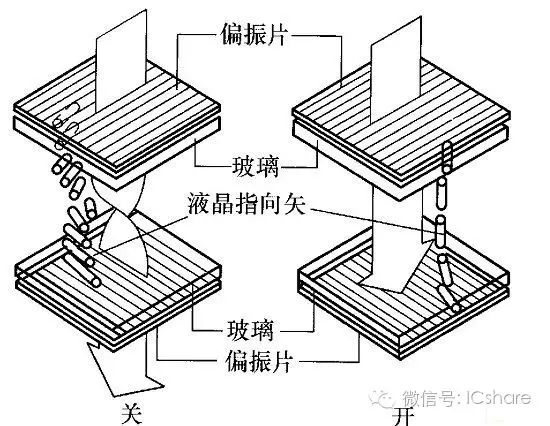
(Basic display principle of TN-LCD)
The response time of liquid crystal flipping is at least 2-4ms, and the backlight principle also prevents LCDs from achieving full black. In contrast, traditional CRT displays are naturally low persistence displays.
To solve this problem, VR headsets must use actively emitting displays, such as OLED. Since each pixel emits light actively, OLED screens can achieve low persistence.
Therefore, AMOLED has many developmental prospects. I hope that domestic AMOLED suppliers can achieve large-scale production soon.